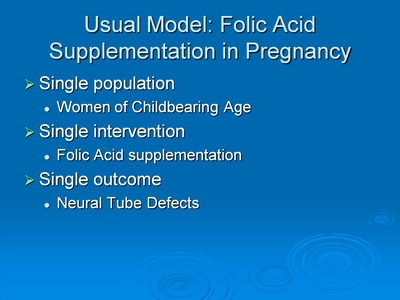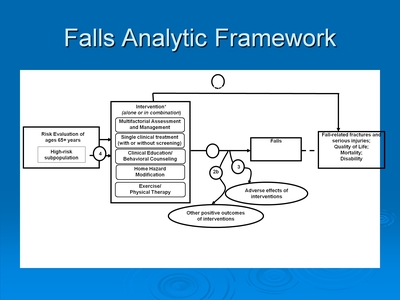Preventive Healthcare for Older Adults
Slide Presentation from the AHRQ 2010 Annual Conference
On September 29, 2010, Roseanne Leipzig made this presentation at the 2010 Annual Conference. Select to access the PowerPoint® presentation (150 KB). Free PowerPoint® Viewer (Plugin Software Help).
Slide 1

Preventive Healthcare for Older Adults
Framing the Issue
Slide 2

USPSTF charge
- Conducts scientific evidence reviews of a broad range of clinical preventive health care services (such as screening, counseling, and preventive medications).
- Develops recommendations for primary care clinicians and health systems.
Slide 3

Usual Model: Folic Acid Supplementation in Pregnancy
- Single population:
- Women of Childbearing Age
- Single intervention:
- Folic Acid supplementation
- Single outcome:
Slide 4

Challenges in Applying Model to the Very Old
- Many geriatric disorders have multiple risk factors, interventions, and expected outcomes.
- Older adults are not often represented in clinical trials and are more heterogenous than younger adults.
- Important outcomes may not be measured and reported in ways conducive to evidence synthesis and interpretation.
Slide 5

Falls Analytic Framework
Image: The Falls Analytic Framework is a chart showing the following process:
Risk Evaluation of ages 65+ years
High-risk subpopulation
→
Intervention (alone or in combination)
- Multifactorial Assessment and Management
- Single clinical treatment (with or without screening)
- Clinical Education/Behavioral Counseling
- Home Hazard Modification
- Exercise/Physical Therapy
→
Other positive outcomes of interventions
or
Adverse effects of interventions
or
Falls
Fall-related fractures and serious injuries;
Quality of Life;
Mortality;
Disability
Slide 6

Ideal Analytic Framework
Image: The Ideal Analytic Framework is a chart showing the following process:
Adults greater than 65 years → (Screening for multiple risk factors*) Adverse effects, High Risk, Low Risk
High Risk →
- Home Inspections
- Exercise and rehabiliation programs
- Multi-factionral risk assessment and management
- Comprehensive geriatric assessment
- Medication management programs
Arrows point from all items on the above list to "Reduced Falls." Arrows point from "Home Inspections," "Exercise and rehabiliation programs," and "Comprehensive geriatric assessment" to "Improved Functional Limitation." Above "Reduced Falls" is another arrow pointing down from "Improved Geriatric Syndromes."
*Risk factors include: increasing age; baseline functional impairment and limitations; incontinence; polypharmacy; medical risks; sensory and cognitive deficits.
Slide 7

Challenges: Nontraditional Outcomes
- Years of Life gained may not be as important as:
- Independent life or maintenance of function
- Quality of life, etc.
- Caregiver outcomes:
- Ability to plan by knowing that a patient is dementing
- Timing of outcomes:
- For syndromes, often can't reverse the underlying progression of disease (frailty, dementia) but can improve for a period of time:
- How short a period of time is clinically significant
- Can outcomes be measured too far out and miss significant short term gains?
- e.g., Hospitalizations at 24 months after a fall intervention?
When to stop screening?
Slide 8

Payment Challenge: Uncovered Preventive Services
- Medicare will now pay for USPSTF Grade A and B recommendations (MIPPA).
- BUT many preventive services have strong evidence showing their benefit, but are not paid for by Medicare:
- Are unlikely to be able to meet the stringent criteria for USPSTF recommendation—that SCREENING will improve outcomes more than waiting for the disorder to be manifest:
- Glasses
- Hearing Aids
- Dentures
- What needs to be done to obtain coverage for these preventive services?
Slide 9

- Elizabeth Eckstrom: Synthesizing the Evidence
- Marcel Salive: Medicare coverage of Preventive Services
Current as of November 2010
Internet Citation:
Preventive Healthcare for Older Adults. Slide Presentation from the AHRQ 2010 Annual Conference (Text Version). November 2010.
Agency for Healthcare Research and Quality, Rockville, MD. http://www.ahrq.gov/about/annualconf10//eckstrom_leipzig_salive/leipzig.htm




